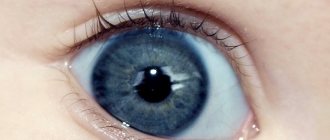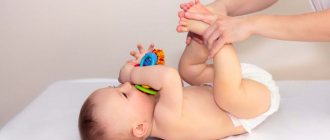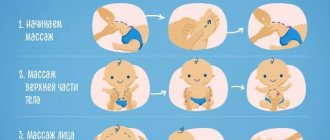Massage of a child with tone: video
In medicine, there is the concept of muscle tone, which consists of small muscle tension present in a state of relaxation and calm.
When there is an impact from the outside, the muscles relax and tense. One of the reasons for such symptoms is mainly increased muscle tone in children, which manifests itself as a result of certain abnormalities. This increased tone is also called hypertonicity in medicine. The main method of treatment and prevention is massage of the child with tone .
When a child is born, he generally experiences an increase in tone. These are purely physiological signs that are associated with the fact that the baby has been in the mother’s tummy for a long time. While the baby is in the womb, his arms, legs, and chin are pressed tightly to the body. In this state, the fetal muscles are quite tense. And this happens throughout pregnancy.
When a child is born, it is necessary to carefully monitor the tone of his muscles. This is done from the first days of a newborn’s life. Right now you can notice all the anomalies that arise quite clearly. If measures are not taken in a timely manner, the result is that gait and alignment are impaired, and the child lags behind in the development of movements. Thus, the primary task of parents is to systematically observe and record all children's postures and movements. And you don’t have to wait until it’s time to visit a doctor. Muscle tone in children, its indicator is not only the basis of various movements. This indicator reflects the holistic condition of the child, as well as his nervous system.
With hypertonicity, the child experiences frequent hysterics, is restless, and has disturbed sleep. Every sound and bright lighting has an irritating effect on him. Since the occipital muscles are tense, the child holds his head well even at birth. The baby's legs and arms are constantly tightening, as if he is trying to bring them together. And when you want to separate them, there is a feeling of resistance. To accurately determine the pathology associated with the nerves, you should once again spread the baby’s legs. If he resists strongly, therefore, there is muscle hypertonicity. Also, a distinctive feature of hypertonicity is pressing the fingers and the desire to rise on the tiptoes. All this affects the baby’s spine and gait in the future. It is quite common to observe tense neck muscles, resulting in tension in the head and back. As a result, the brain structures are very active, intracranial pressure increases, and the child is very excited. Until six months, hypertonicity is not dangerous, it’s just physiology.
Hypertonicity is mainly noticed in the baby’s legs and arms. To check the tone in the legs, the child is taken under the arms and placed on his feet, slightly tilted forward. The baby must be placed on a flat surface. The child begins to stomp like an adult. If there is tone, the baby stands on tiptoes.

If there is tone in the hips, then when spreading the legs to the sides, strong resistance is felt. If the child is healthy, then there is no reaction from him to such actions; he freely allows all this to be done. If such signs persist even after six months, it is recommended to contact a neurologist and pediatrician.
Massage for a child for muscle tone
To get rid of the manifestations of increased muscle tone, you need to do a special massage that relaxes the muscle tissue.
The environment should be comfortable:
- Ventilated room;
- Massage table;
- Clean hands;
- The procedure is performed after eating 40 minutes;
- It is advisable to use powder or cream;
- The child should be in a calm state;
- The massage is done for five minutes, and after three months it increases to ten minutes.
The massage technique includes muscle relaxation.
Main techniques in massage:
- Stroking movements to relieve tension and improve blood circulation.
- Hand massage is performed alternately.
- Foot massage is performed while lying down, as the legs rise and fall.
There are also certain techniques that massage therapists perform. Using them, increased muscle tone is relieved and pathologies do not develop.
hypertonicity of the legs in a child
Sitting down by hands
Place the child on his back, on a hard, flat surface, take him by the wrists and gently pull him towards you, as if sitting him down. You should feel moderate resistance as you extend your elbows. If the child's arms straighten without resistance, and in a sitting position, the stomach is strongly protruded forward, the back is like a wheel, the head is tilted back or lowered down - these are signs of decreased tone. If you cannot move your child’s arms away from the chest and straighten them, this, on the contrary, indicates hypertonicity. As the child grows older, in response to pulling on the arms, the child will try to pull himself up and sit down.
Step reflex and support reflex
Take the baby by the armpits, “put” him on the changing table and slightly tilt him forward, forcing him to take a step. Normally, the child should stand on his full foot with his toes straightened. And when bending forward, the newborn imitates walking. If the baby crosses his legs and rests only on his toes, this is a sign of increased tone. This reflex gradually fades away and by 1.5-2 months it practically disappears. If a child older than 2 months still has a step reflex, this is evidence of hypertonicity. Instead of standing, does the newborn crouch, take a step on strongly bent legs, or refuse to walk at all? This indicates decreased tone. If a child stands on tiptoes with one foot and dances with the other, this is dystonia.
Symmetrical and asymmetrical reflexes
Place your baby on his back with your palm under the back of his head and gently tilt the baby's head toward your chest. He should bend his arms and straighten his legs. Then place the baby on his back and slowly, without force, turn his head towards his left shoulder. The child will take the so-called fencing pose: extend his arm forward, straighten his left leg and bend his right leg. Then turn the child’s face to the right - he must repeat this pose, only in its “mirror” version: he will stretch his right arm forward, straighten his right leg and bend his left. Asymmetric and symmetric reflex gradually disappear by 2-3 months. The presence of these reflexes in a three-month-old child indicates increased tone, and their absence in the first two months of life is, on the contrary, a sign of decreased tone.
Tonic reflex
Place the baby on his back on a hard surface. In this position, the newborn’s extensor tone increases, he tries to straighten his limbs and seems to open up. Then turn the child onto his stomach, and he will “close” and pull his bent arms and legs under him (the tone of the flexors increases on the stomach). Normally, the tonic reflex gradually disappears by 2-2.5 months. If it is absent in a newborn, this indicates decreased tone. And if by three months the tonic reflex does not go away, this is a sign of hypertonicity.
Moro and Babinski reflexes
The Moro reflex involves throwing your arms out to the sides when overexcited. And the Babinski reflex is expressed in the reflex extension of the toes when the foot is irritated or tickled. Normally, both reflexes should disappear by the end of the 4th month of life.
Motor development:
If the syndrome of muscular hypertension is not clearly expressed, its influence on the development of static and locomotor functions may manifest itself in their slight delay at various stages of the first year of life. Depending on which muscle groups have more increased tone, differentiation and final consolidation of certain motor skills will be delayed. Thus, with an increase in muscle tone in the hands, a delay in the development of directing the hands to an object, grasping a toy, and manipulating objects is noted. The development of grasping ability of the hands is especially impaired. Along with the fact that the child begins to pick up the toy later, he retains an ulnar grip, or grip with the entire hand, for a long time. The finger grip (pincer grip) develops slowly and sometimes requires additional stimulation. The development of the protective function of the hands may be delayed, and then the balance reactions in the prone position, sitting, standing and when walking are delayed. With an increase in muscle tone in the legs, the formation of the support reaction of the legs and independent standing is delayed. Children are reluctant to stand on their feet, prefer to crawl, stand on their toes (on tiptoes) when supported - this is very bad.
Muscle hypertonicity in children under one year of age: symptoms, consequences and treatment, massage for hypertonicity
Hypertonicity is a violation of the muscle tone of the body, which is expressed in muscle overstrain. Almost all babies are born with severe muscle hypertonicity. After all, while inside the womb, the baby is constantly in the fetal position. The limbs and chin in this position are pressed closely to the body and the muscles of the fetus are constantly tense.
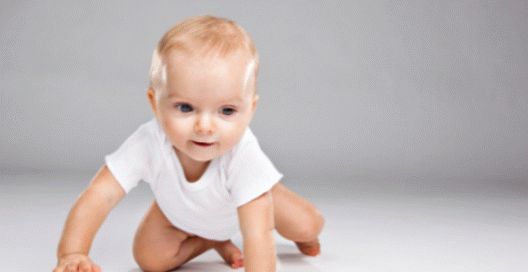
hypertension in children under one year old
Until about six months, the baby’s nervous system “learns” to work in conditions different from those in the womb. The baby gradually develops and slowly begins to control the movements of his muscles and skeleton. In a one-month-old baby, hypertonicity is very pronounced. This is reflected in clenched fists and bent legs, and in throwing the head back. The tone of the extensor muscles in a one-month-old baby is higher than the flexor muscles.
With physiological hypertonicity, the child’s legs move apart only 45 0 each. When moving your legs away, you feel a pronounced resistance to movement. By three months, muscle hypertonicity in a child without pathologies practically disappears. If muscle tension persists after your child reaches six months, you should immediately consult a doctor.
What is muscle hypertonicity
A newly born little person always experiences muscle strain. This deviation is explained by the fact that during prenatal development the child is in a curled position, where the limbs are pressed to the body.
As soon as he begins to live, all his systems and organs must adapt to other conditions and recover within six months.
Hypertonicity of muscles in infants, with normal development, disappears at 3-4 months of life
Muscle hypertonicity in infants begins to subside as soon as they control their movements. At this time, their flexion reflex is more developed. It is necessary to provoke skin receptors more often (children respond well to them), in response to which extensor receptors will also develop.
In the first month, the child’s tension manifests itself especially clearly:
- closed fists;
- bent legs, which, with strong resistance, move apart;
- putting the head on the back.
If there are no developmental abnormalities, then by the age of 3 months such symptoms disappear on their own.
To improve the development of different muscle groups, you need to carry out the following activities with your kids:
- do not swaddle the child, which will allow him to move his arms and legs independently;
- gymnastics classes;
- light full body massage;
- provoke a positive reaction from the baby to affectionate communication;
- perform warm water procedures every day.
But if there is tension in the child’s muscular system, which does not go away until six months, then it is necessary to take action and contact the attending doctor for advice.
Symptoms of hypertension
Video:
Complications during pregnancy, birth injuries, Rh conflict, incompatibility of the blood of parents, residence in a poor environmental situation and many other factors will cause hypertension. It is worth paying close attention to the symptoms of hypertonicity, because this can be an expression of a serious neurological disease.
Signs of severe hypertension:
- Restless and short sleep.
- In the lying position, the head is thrown back, and the arms and legs are tucked.
- When trying to separate the baby's legs or arms, strong resistance is felt. The child cries at the same time. Secondary dilution increases muscle resistance.
- Vertically on a hard surface, the child tries to stand on the front part of the foot, that is, stands on tiptoes (Information: if the child walks on tiptoes).
- When crying, the child throws his head back, arches, and at the same time his chin muscles tremble (See the article on chin tremor).
- Frequent regurgitation.
- Painful reaction to various stimuli: light, sound.
- From birth, the baby “holds” his head due to constant tension in the neck muscles.
Treatment
Correct and timely treatment of hypertension is carried out exclusively by a specialist doctor - a pediatric neurologist. All procedures are prescribed only by the attending physician. The sooner you start treatment, the better and faster the positive results will appear.
There are several techniques and directions in medicine that allow you to relieve hypertension:
- Relaxing massage.
- Physiotherapy.
- Electrophoresis.
- Paraffin applications (heat therapy).
- Swimming.
- Drug treatment.
As can be seen from the list, to remove hypertension, medications are used last. These are drugs that relax muscles, reduce muscle tone and diuretics to reduce brain fluid levels. In addition to the massage, dibazole and B vitamins may be prescribed.
Massage
Massage for hypertonicity can be done independently at home starting from two weeks of age. Naturally, you first need to consult with a specialist in children's massage and get instructions and recommendations for massage from him. A total of ten sessions are carried out, which are best repeated again after six months.
The massage consists of three types of influence techniques: stroking, rubbing and rocking:
- With the back of your hand we stroke the surface of your arms, legs and back. You can alternate superficial stroking with your fingers with grasping stroking with the whole brush.
- Circular rubbing of the skin. The baby is placed on his tummy and rubbed in a circular motion with his fingers using stroke movements from bottom to top. Then the same is done with the limbs, turning the child onto his back.
- Take the baby's hand and shake it slightly. In this case, you should definitely hold your hand in the forearm area. Carry out the procedure with both arms and legs.
- Take the baby by the arms above the wrist and rhythmically swing his arms in different directions.
- Grab the child's legs by the shins and rock them.
- Finish the massage by gently stroking your arms and legs.
If you have hypertonicity, you should not use deep muscle kneading, patting or chopping techniques. All movements should be smooth and relaxing, but rhythmic.
Video: how to massage for hypertonicity
Baths
An excellent remedy for relieving hypertension are herbal baths. Water itself has a relaxing property, and in combination with herbs it becomes an excellent remedy for hypertension. Take turns for four days to take warm baths with valerian root, lingonberry leaf, motherwort and sage. A break is taken for one day, the procedures are repeated again, and so on for 10 days. Pine baths also have an excellent relaxing effect.
Breathing massage for flexor hypertonicity
The child should lie on his back with his legs facing the massage therapist:
- using the palmar surface of the hand, they stroke the anterolateral surface of the chest, the oblique abdominal muscles, bypassing the cartilaginous zone;
- They stroke the intercostal spaces of the oblique and rectus abdominal muscles, and the muscles along the colon. The techniques are alternated 2-3 times;
- lay the child on his stomach and begin to stroke and rub the trapezius muscles along the way;
- Place the child on his back and stroke the chest and oblique abdominal muscles.
Relaxing breathing massage is alternated with gymnastics - passive flexion and extension of arms and legs, reflex extension of the spine in a position on the side (right and left), reflex movements of the feet when pressing the feet with fingers from toes to heel, reflex movement of the head and crawling in a position on the stomach .
Baby massage at the age of 3 months
Baby massage at the age of 3 months with residual hypertonicity should be done according to the method described above and press with a finger at the base of the phalanges for reflex flexion, and also stroke from the toes to the heel along the outer part of the foot.
It is useful to do:
- stroke the baby’s buttocks with your palm 6-8 times, holding the shins or thighs with your other hand;
- arch your back;
- lift 2-4 times, placing one hand under the chest, the other - grab both legs in the ankle area. At the same time, the baby’s back will also reflexively bend.
Baby massage at the age of 4 months
Baby massage at the age of 4 months with the presence of residual hypertonicity is performed with stroking and rubbing movements. The child is held with one hand, and a spiral massage is performed with the other hand (4-6 times):
- along the shoulder, its outer surface;
- along the feet and from the foot up the lower leg and thigh.
The massage is combined with raising the legs: grasping the legs in the area of the calf muscles, alternately raising and lowering the straightened legs.
Abdominal massage is performed according to the method described above.
You can rub your back from the spine along the intercostal spaces to the sides, repeating 4-8 times.
The buttocks are rubbed in a spiral pattern, holding the baby’s legs with one hand. Then they help the child turn onto his stomach, pulling his hand to the side. In this case, the child will try to pull up his head and throw his leg to the side to turn. Additionally, you can easily stroke the side of the chest and the outer surface of the thighs with your finger (with your second hand) to turn the baby onto his stomach.
Baby massage at 5 months
Children's massage at 5 months with residual symptoms of hypertonicity is supplemented with a stroking massage of the dorsum of the feet from the fingertips towards the ankle. Then ring rubbing from the ankle to the knee and thigh, kneading the legs in the child’s position on the back and a combination of massage with alternating leg bending: the legs are held by the shins and alternately bent at all joints, straightened and doing a “bicycle”.
Baby massage at 6 months
Children's massage at 6 months with pathological hypertonicity or residual hypertonicity is supplemented by kneading the hands. The child grabs the finger of one hand of the masseur. With the second hand, unclench the muscles of the inner surface of the forearm and shoulder 4-8 times. Kneading the legs is performed with the child in the position on the back and stomach. Then knead the buttocks with the fingers of both hands and stroke the back muscles. Using your fingertips, gently tap along the spaces between the ribs from the spine to the sides, repeating 8-12 times.
How to properly massage for toned legs in children?

Every young mother needs to learn how to do a massage to tone the legs of children. For nine months the baby is in a woman’s womb in an awkward position. At this time, his still not fully formed muscles experience overstrain. Therefore, after birth, infants most often experience increased muscle tone. Massage will help cope with this problem. The main thing is to remember a few basic rules for the procedure.
Types of muscle hypertonicity
Muscle hypertonicity in infants, which lasts for 6-7 months, is dangerous for the baby’s health and negatively affects its further development. This may indicate malfunctions in the functioning of brain tissue.
If you do not take any measures to eliminate muscle strain, the following may occur:
- late extension of fingers;
- speech and circulatory disorders;
- motor delay (walking, sitting);
- movement coordination.
Therefore, if symptoms of increased muscle tone appear in a child, it is necessary to contact a pediatric neurologist.
Doctors distinguish the following types of hypertension:
- overexertion affects only the legs;
- affects the upper limbs;
- language.
There is a complete pathology, when the tone covers the entire body.
Symptoms of increased leg tone
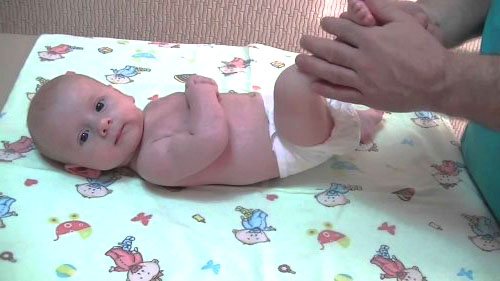
For an accurate diagnosis, consult your pediatrician. It is not difficult to recognize hypertension at an early age. Every mother can do this based on visual signs. There are several main symptoms:
- Strong crying and constant restlessness of the baby.
- Lack of restful sleep. Each time the child tries to assume the fetal position. Cries often.
- After each feeding the baby spits up.
- The baby constantly tightens his legs.
- A sharp reaction to any sounds or bright light.
- When you try to move your legs to the side, you feel significant resistance.
If symptoms are detected, you should immediately begin a course of massage to tone the legs in children.
If you are not sure that you have correctly identified your baby's condition, consult your pediatrician.
Hypertension must be treated. It not only causes suffering to the baby, but also inhibits the development of his musculoskeletal system. Children with this diagnosis begin to crawl and walk much later than their peers.
Basic recommendations and preparation for massage
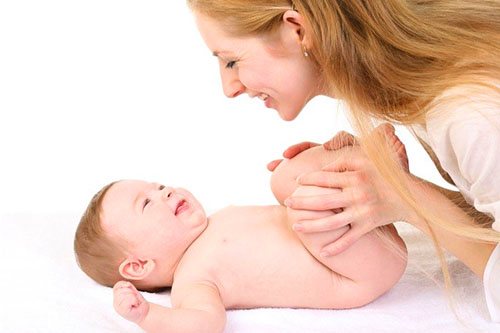
The session can only be carried out if the baby is relatively calm. If he is too capricious, then a positive effect will not be achieved. In this case, it is better to postpone the procedure to another time. During a baby massage for hypertonicity, adhere to the following recommendations:
- Before the session, it is necessary to create a comfortable atmosphere in the room. The room temperature must be maintained at 23 degrees at all times. Make sure there are no drafts. Eliminate all unpleasant odors and loud sounds.
- Prepare the area for the massage. It is best to use a special table. If it is not there, you can carry out the procedure on a changing table. Cover it with a blanket. Place an oilcloth on top and cover it with a clean, hot ironed diaper.

- Wash your hands thoroughly. They should not be wearing rings or bracelets. Keep your nails trimmed, as their sharp edges can hurt your baby's delicate skin.
- It is recommended to carry out the procedure on an empty stomach. Wait at least 45 minutes after feeding. You should also not feed the baby immediately after the session. Let it rest for at least an hour.
- To tone the legs of children, massage should be done on clean, dry skin. Do not use petroleum jelly, cream or powder. Give your skin the opportunity to breathe fully.
- During the procedure, make all movements in the direction from the feet to the groin area. Make sure your actions are as smooth and gentle as possible. Any too much pressure may cause injury.
If these recommendations are followed, the session will be as comfortable as possible for the baby and will benefit his health.
The duration of the session for infants should not exceed five minutes. At an older age, you need to massage your legs for ten minutes.
To successfully cure hypertension, ten sessions are enough. After six months, the course can be repeated.
Massage technique
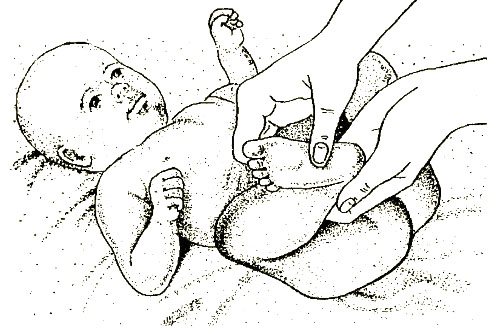
The rules for performing a massage for muscle hypertonicity in a child are quite simple. Any mother can master it. Follow the following sequence of actions:
- Carry out the procedure with warm hands. To do this, rub your palms together.
- You also need to warm up the baby's skin. To do this, gently stroke the legs with your palms.
- Exercise will help relieve general tension in the lower body. Lay your baby on his back. Place your hands under the baby's lower back. Lift your body and rock it slightly from side to side.
- Place the baby on his back. Raise one leg. Place it on your palm. With your other hand, gently stroke the entire leg from the foot to the groin area. Repeat similar steps with the other leg. Try to avoid impact on the kneecap.
- Place your baby's foot between your two palms. Using rubbing movements, go over the entire limb.
- Wrap your hand around your leg. Use vigorous pressing movements. Don't overdo it, don't push too hard.
- Shake your baby's leg with gentle, gentle movements. If hypertonicity is too pronounced, then this technique is contraindicated.
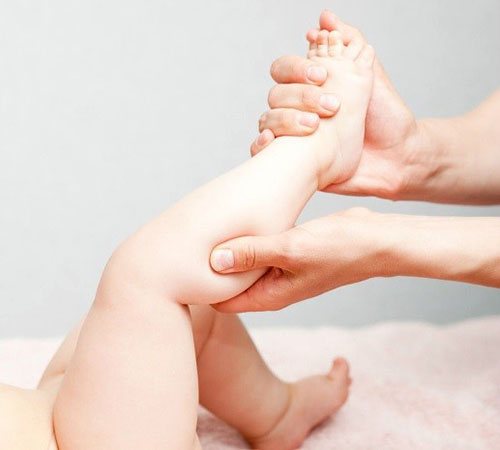
- Slightly spread your baby's legs apart. Lightly shake and flex your feet. Massage your feet. After this, stretch the muscles of your legs.
- Bend the baby's limbs so that you get a right angle. Use smooth movements with light vibration to press on the soles of your feet. Apply light pressure to the Achilles tendon.
- Flex and straighten your baby's limbs. Such actions must be repeated at least 10 times. This exercise will not only help relieve tension, but also have a beneficial effect on the functioning of the joints.
- Draw a figure eight on each child's foot. At the same time, start moving from your fingers. The crosshair of the figure eight should be located in the middle of the foot. After this, massage each finger.
- The final stage of the procedure is stroking movements over the entire surface of the foot and leg.
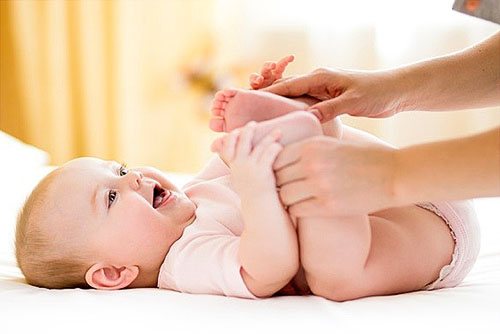
If some techniques remain unclear to you, study the video of a massage for hypertonicity of a child’s legs. This way you can better understand all the features of the procedure.
During such a massage, you should not make chopping or clapping movements. Such actions can have the opposite effect and increase muscle tension.
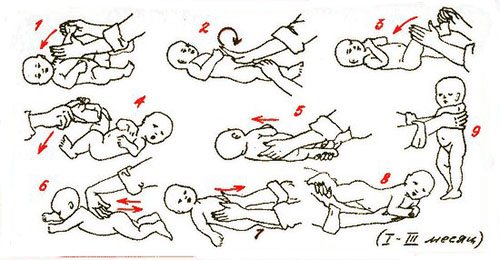
Massage is the most effective remedy in the fight against hypertension. Study the methodology for doing it. If you are not confident in your own abilities, consult a specialist.
Massage technique for flexor hypertonicity
Massage of the arms, legs, feet, chest, abdomen and back is performed for 1-3 minutes with light strokes (superficial, planar, ironing, rake-like).
Hand massage
Hand massage should be performed with the child lying on his back. When massaging the baby’s left hand, place the finger of the masseur’s right hand in the baby’s palm, and with the left hand grab the wrist joint and move the hand along the flexor muscles towards the shoulder.
Massage of the right hand is also done with the right hand, and with the left hand you need to support the baby’s left arm in a half-bent position. After 10 days, a rubbing technique (sawing and shading) is added to the stroking.
Foot massage
Children's foot massage is performed on the child in a supine position with the feet facing the massage therapist. With one hand you need to hold and lift the opposite leg by the foot. In this case, it should lie on the palm in a slightly bent position. Stroke with the other hand along the surface of the legs outward and backward in the direction from the foot to the groin area. After 10 days, rubbing techniques are added.
Foot massage
Foot massage should be done using the cone of the thumb, with pressure along the entire foot from the toes to the heel. At the same time, the toes will reflexively extend.
Abdominal massage
Abdominal massage should be done clockwise using two hands: the palm of the right hand performs stroking movements of the left half of the abdomen from top to bottom, the palm of the left hand strokes the right half of the abdomen from bottom to top. Repeat 6-8 times.
Breast massage
Breast massage is performed without increased finger pressure! You need to make light stroking massage movements along the intercostal spaces from the sternum to the sides. Repeat 2-4 times. Turn the child onto his stomach and perform a back massage.
Back massage
The back massage begins by stroking from the neck to the buttocks with the palms of both hands. Then with the back of the hand - from the buttocks to the head, repeating 4-8 times in each direction.
Massage for hypertension


